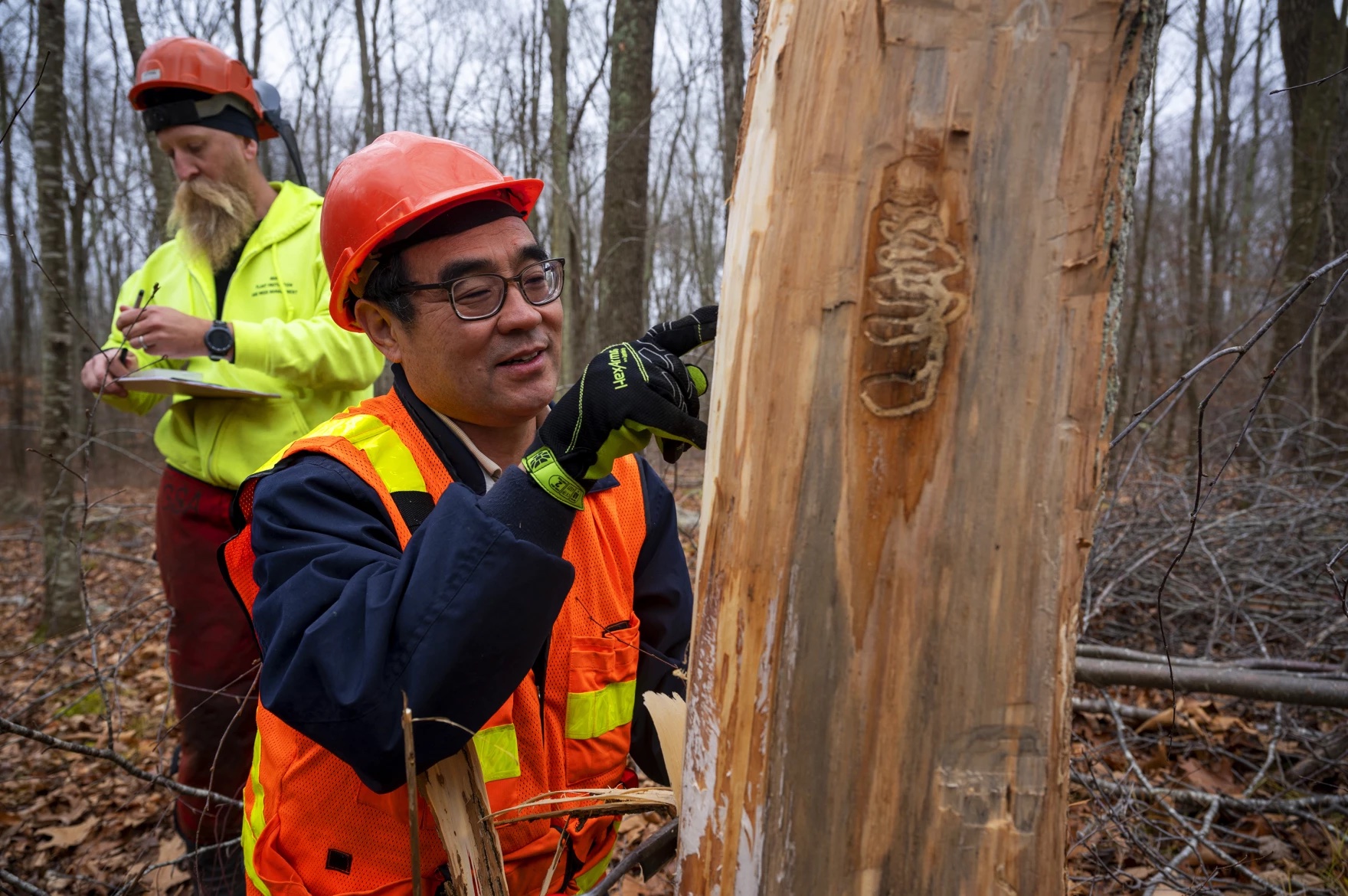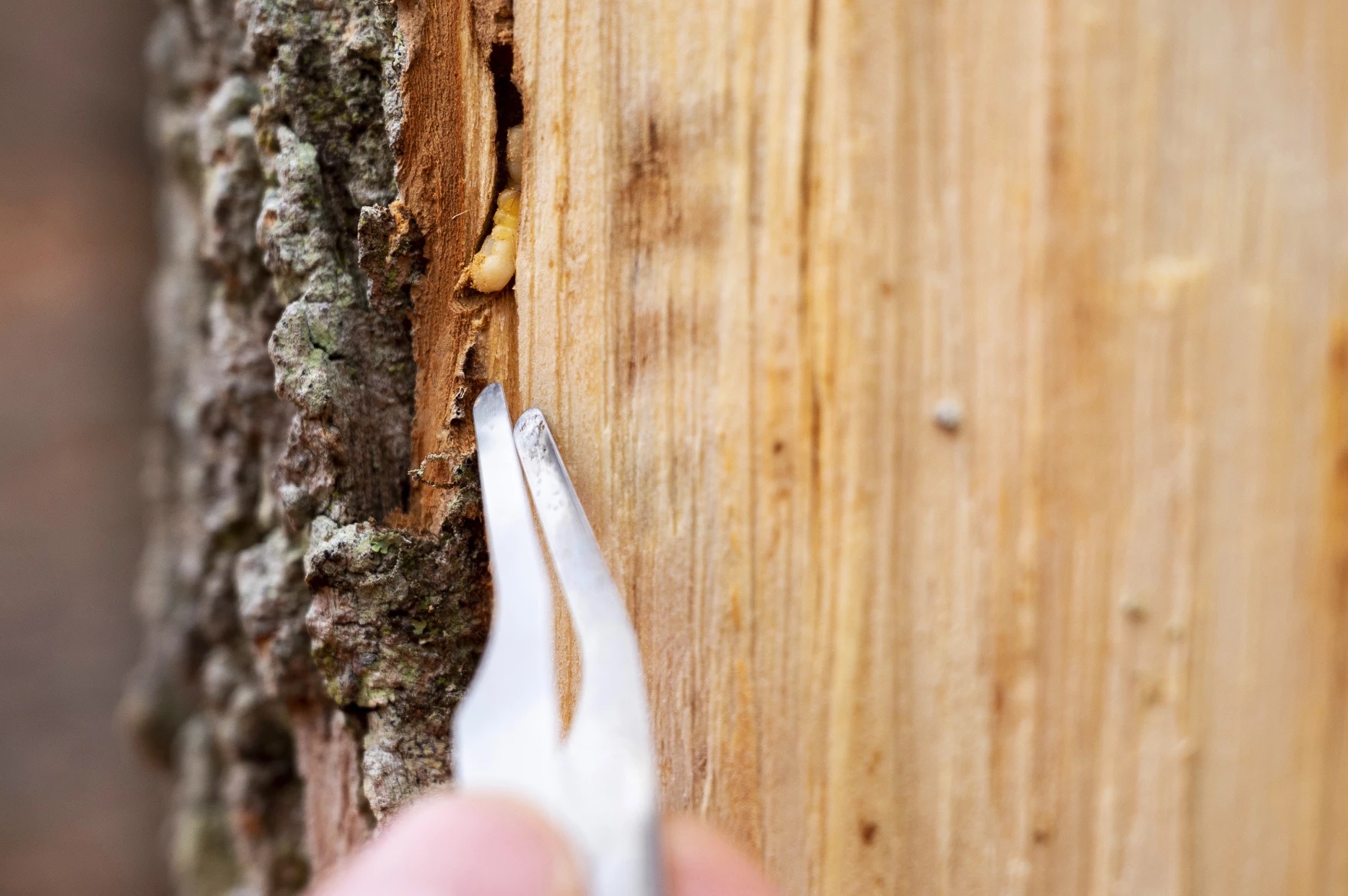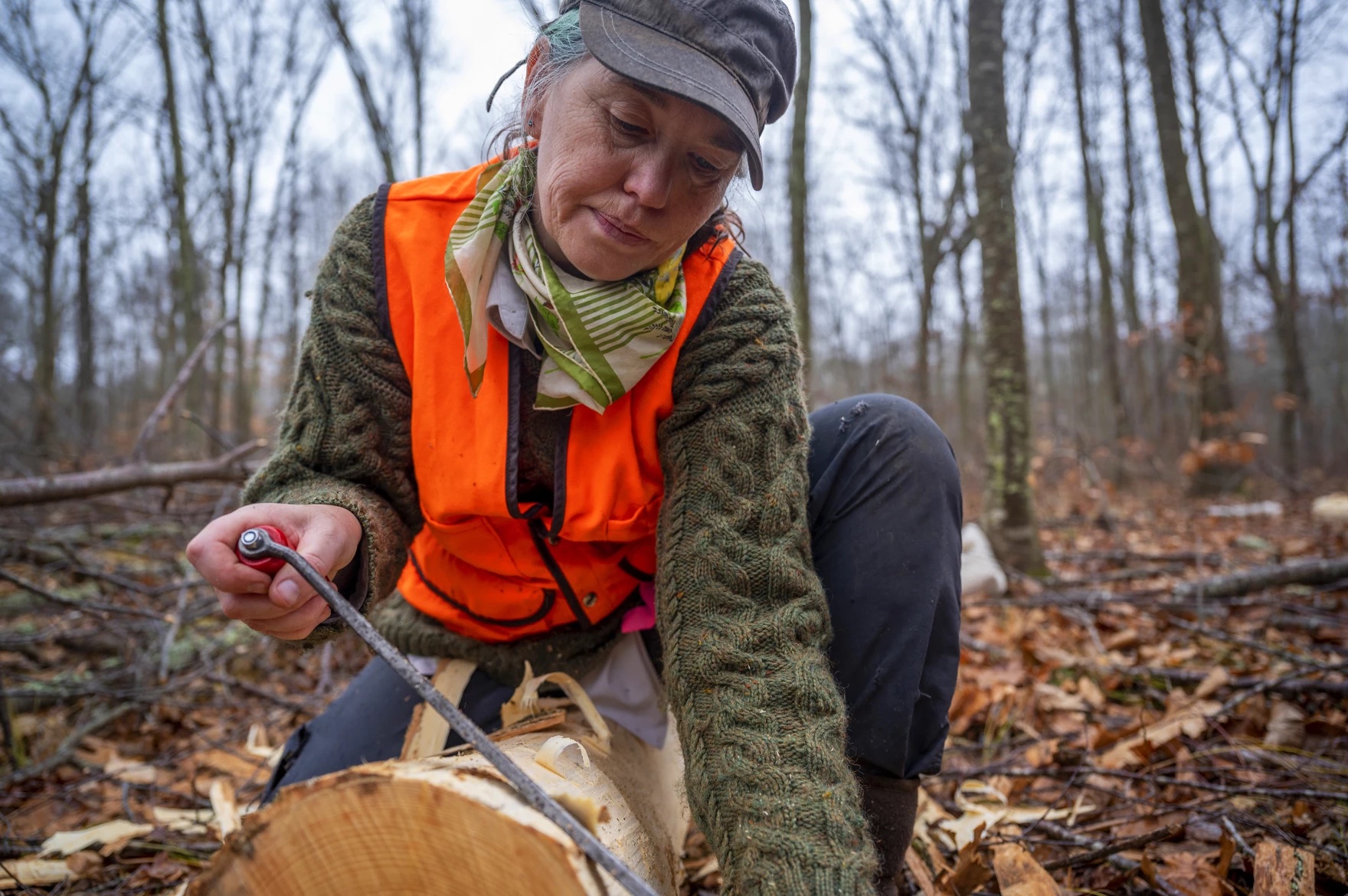How These Russian Wasps Could Help Save Ash Trees
7:22 minutes

This article is part of The State of Science, a series featuring science stories from public radio stations across the United States. This story, by Patrick Skahill, was originally published by Connecticut Public Radio.
How do you find an insect the size of your fingertip in a densely packed forest?
For Jian Duan, the answer is simple: Follow the dead ash trees.
On a rainy day in eastern Connecticut, Duan, a federal research entomologist with the U.S. Department of Agriculture, walked to a dying ash covered with holes. Peeling back the bark with a drawknife, he revealed a mess of serpentine tunnels. Curled up inside was one of his targets: a larva of emerald ash borer.
“Let’s collect it,” Duan said, gesturing as his assistant handed him a pair of tweezers tied to a brightly-colored ribbon.
(In case you’re wondering, the ribbon makes the tweezers easy to spot when they’re dropped on the leaf-covered ground.)
But today Duan isn’t just collecting emerald ash borers. He’s also looking for their predator, one released here on purpose in 2019 and 2020: a wasp known as Spathius galinae (pronounced spay-see-us glee-nuh).
“It’s from the Russian Far East,” Duan said, smiling. “Unfortunately, there are no common names for these parasitic wasps.”
The stingless wasp is tiny – about the size of a mosquito. But scientists have big hopes for it.
In Russian forests, this wasp naturally targets and attacks emerald ash borer.
“Emerald ash borer, in its native range, northeast Asia, [does] not kill trees like this,” Duan said.
And if this experiment works, the borers won’t kill as many trees here either.

Solutions like this, known as biological control, are one way scientists can deal with biological problems like the invasive emerald ash borer. Right now there are experiments across New England to see if the wasps can help save the region’s ash trees.
Connecticut and Massachusetts began using the “biocontrol agents” in 2013. Maine, New Hampshire and Vermont are doing similar experiments, hoping to stop a devastating pattern.
Claire Rutledge, with the Connecticut Agricultural Experiment Station, says when emerald ash borer feeds on trees, it cuts off key nutrient pathways. For ash trees, that’s death by a thousand cuts.
“One larva is not a big deal. Twenty larvae are not a big deal. Two thousand larvae kill the tree,” Rutledge said.
Since it was first detected in Michigan in 2002, emerald ash borer (EAB) has killed tens of millions of ash trees. Federal officials estimate it has cost municipalities, nursery operators and the forest-product industry tens of millions of dollars. The massive die-off of ash trees has also disrupted the making of culturally important products like baskets and baseball bats.
Duan said the idea of biocontrol is to find the natural predators of an introduced pest and bring them to the new environment to slow the pest’s spread.
“Because in the native range, these natural enemies co-evolved with the pest,” Duan said.
Shortly after EAB arrived in the U.S., DNA testing traced its origin to northeast Asia. Duan traveled to Russia – trekking through cold forests to collect wasps that only prey on EAB. Samples were brought to America, quarantined and carefully tested for years to ensure the wasps wouldn’t kill any other non-target species.
Now that some of these wasps have been living in the forests of Connecticut and Massachusetts for about 10 years, scientists are trying to find out if the intervention is working.

As Duan and his assistant peel more bark and pull more larvae from the dying tree in Connecticut, they still can’t find the Russian wasp or two other species that were introduced here. So they decide to cut down the tree to study it further.
They cut the wood into meter-long segments and continue looking.
Rutledge said it’s too late for the wasp to stop the massive wave of EAB that’s killing older ash trees. But there is hope for the younger trees that are just starting to grow.
“When regeneration starts to happen, after the EAB levels drop, the parasitoids will be able to keep those populations down so that the new ash can grow and escape,” Rutledge said.
On this old ash tree, they found a few EAB larvae – and no wasps. But they did find parasitoids just a few miles away at another site they’re studying. And as recently as last year, Rutledge said they found reproducing populations of wasps initially introduced in 2013.
So, she said, it’s looking like success: The wasps are sticking around and spreading.
“I’m really cautiously optimistic,” Rutledge said. “The problem with bio control is it’s going to be 10 or 15 years later when we see how much of a resurgence the ash manages.”
Even then, she said, it will be a long time before we see big, healthy ash trees in New England forests again.
Patrick Skahill is a Science and Environment Reporter at WNPR Connecticut Public Radio in Hartford, Connecticut.
IRA FLATOW: This is Science Friday. I’m Ira Flatow. Now it’s time to check in on the state of science.
SPEAKER 1: This is KER–
SPEAKER 2: For WWNO Saint Louis Public Radio.
SPEAKER 3: Iowa Public Radio News.
IRA FLATOW: Local stories of national significance. About 20 years ago, scientists in the US identified an invasive insect, the emerald ash borer, that would go on to wreak havoc in forests. It’s a very small metallic green bug about the size of a grain of rice. It is tiny, but lethal. These bugs have killed millions of ash trees. Their larva bore into the tree. They feed on the part that moves water and sugar around, and then slowly starve the tree to death.
In a race to save the ash trees, researchers hatched a plan to use parasitic wasps to keep emerald ash borer populations under control. It’s called biocontrol. So how’s the plan playing out? Here with the update is Patrick Skahill, reporter and editor at Connecticut Public Radio in Hartford, Connecticut. Welcome to Science Friday. Nice to have you back.
PATRICK SKAHILL: Thanks. Glad to be here.
IRA FLATOW: This is really a deadly little bug. Isn’t it?
PATRICK SKAHILL: This is a deadly bug, Ira. And you set it up perfectly in your intro. This is an insect that was first detected in Michigan in 2002. Probably arrived in the US a little bit earlier than that. Since then, it’s gone across to at least 30 states in the US. Killed tens of millions of ash trees. I spoke with an entomologist here in Connecticut, Claire Rutledge is her name. She described emerald ash borer and its impact on trees this way.
CLAIRE RUTLEDGE: So one larva is not a big deal. 20 larvae are not a big deal. 2,000 larvae kill the tree.
PATRICK SKAHILL: And so it’s really a problem of scale. In its native range, where emerald ash borer exists in Asia, there have been predators that have kind of co-evolved with these pests to keep them in check. But when emerald ash borer came to the US, in many ways, entomologists told me it was a novel threat. It was kind of COVID for trees. It came in. The trees didn’t have a defense for it. It hit them hard, and it killed them off. And when these insects would swarm these trees in thousands and thousands of numbers, the trees just didn’t have the strength to fight that off.
It’s cost, according to federal officials at the USDA, municipalities, nursery operators, the forest product industry tens of millions of dollars. And it’s affected industry too. Things you might not think of like basket weaving, that can rely on using ash trees. Baseball bats is another big one. Ash baseball bats are quickly going away because the ash trees just aren’t there anymore.
IRA FLATOW: So experts brought in some parasitic wasps to help. Tell us about that. What did they do to the emerald ash borer?
PATRICK SKAHILL: Yeah. So this is something called biocontrol. And it’s not a new idea. The basic idea here is when a pest comes in, you find a predator that can handle it. Jian Duan is a federal research entomologist with the US Department of Agriculture who described it this way.
JIAN DUAN: So basically the idea is to re-establish connection with the exotic or invasive pest. Because in the native range, these natural enemies co-evolved with the pest.
PATRICK SKAHILL: When emerald ash borer was first detected here in the US, that’s what scientists did. They went over to Asia. They searched literature. They talked to people. And found wasps that prey on emerald ash borer. Right now, the USDA says there are four known stingless wasps– and these are wasps that don’t sting people– that will either attack EAB larva or its eggs. And the services currently evaluated a fifth wasp.
IRA FLATOW: Why is it that Russian wasps do the job but none here in the US?
PATRICK SKAHILL: Yeah. So one of the things that scientists here in Connecticut are actually looking at is a wasp that’s adapted to the cold of the Russian Far East, which is good for New England because it gets cold here. So they brought that wasp over here. And have used it in New England forests because they think it might be a little bit more hardy, and a little bit more able to withstand the cold temperatures that happen here in the winter.
IRA FLATOW: When people hear about wasps being released, they’re kind of scary because they’re wondering whether they’re going to come after us and sting us.
PATRICK SKAHILL: Yeah. And so these are– again, these are stingless wasps. And the research process for bringing these over here and ensuring that they will only attack target species, in this case emerald ash borer, is an extensive one. The USDA, according to Duan, spent years evaluating these wasps in isolation in labs where there was key access to get in to interact with these specimens that they had. And they just threw a lot of potential host species at it. And found, no, in fact these wasps really only do target emerald ash borer.
Once the science on that played out, again, over the course of years, scientists from multiple countries had to sign off on this. And then these releases did happen.
IRA FLATOW: I know that you went out with these researchers to look for the wasps. Tell us what that was like.
PATRICK SKAHILL: Yeah. It’s a very interesting process that takes a lot of time. So these researchers who are literally walking through a forest looking for ash trees that are either dead or very close to being dead. They have a draw knife, which is something that you can use to peel back the bark on the tree. And when they do that, they’re looking for trees when they peel back the bark, they see these sort of serpentine tunnels that are in there. That are really indicative of emerald ash borer larva, which get into the tree again and bore their way through.
When they find those, they’ll look for evidence of the wasp. And it’s really a matter of just going tree to tree collecting data. And then collecting enough data that they can kind of create bigger models that show how these wasps are controlling emerald ash borer. And whether or not they’re staying in the area where they were introduced. Or are they going on and following the leading edge of these outbreaks as they spread across the country.
IRA FLATOW: Well, tell us about that. Because it’s been 10 years since the wasps were introduced in Connecticut. And how well is this plan shaping up?
PATRICK SKAHILL: Yeah. So Connecticut and Massachusetts here in New England began using biocontrol agents in 2013. Maine, New Hampshire, Vermont, they’re all doing similar experiments. Again, let’s hear from Claire Rutledge to get her take on how this is going so far.
CLAIRE RUTLEDGE: You know, so I’m really cautiously optimistic. The problem with biocontrol is it’s going to be 10 or 15 years later when we see how much of a resurgence the ash manages.
PATRICK SKAHILL: And so here in Connecticut, again, these wasps were released in 2013. It’s been 10 years. I think one of the initial concerns was that the wasp wasn’t going to stay put. They were going to pig out when there was a major outbreak of emerald ash borer. And then they were going to kind of follow that outbreak as it moved out. But they’re not finding that. They’re actually finding reproducing populations are still in the areas where they were introduced 10 years ago. And they’re staying here in Connecticut.
So Rutledge says she’s optimistic about that because while the ash trees that are here are gone, and are not going to come back, the young seedlings that are growing up might be able to combat emerald ash borer a little bit better in the future because this ambient population of the wasps will be existing later on.
IRA FLATOW: It’s just that the wasps like a lot of things about Connecticut as we do. Right, Patrick?
PATRICK SKAHILL: You know, who could blame them for leaving. Right? What a wonderful place to be.
IRA FLATOW: Patrick Skahill, reporter and editor at Connecticut Public Radio based in Hartford. Thank you for joining us.
PATRICK SKAHILL: Of course.
Copyright © 2023 Science Friday Initiative. All rights reserved. Science Friday transcripts are produced on a tight deadline by 3Play Media. Fidelity to the original aired/published audio or video file might vary, and text might be updated or amended in the future. For the authoritative record of Science Friday’s programming, please visit the original aired/published recording. For terms of use and more information, visit our policies pages at http://www.sciencefriday.com/about/policies/.
Rasha Aridi is a producer for Science Friday and the inaugural Outrider/Burroughs Wellcome Fund Fellow. She loves stories about weird critters, science adventures, and the intersection of science and history.
John Dankosky works with the radio team to create our weekly show, and is helping to build our State of Science Reporting Network. He’s also been a long-time guest host on Science Friday. He and his wife have three cats, thousands of bees, and a yoga studio in the sleepy Northwest hills of Connecticut.